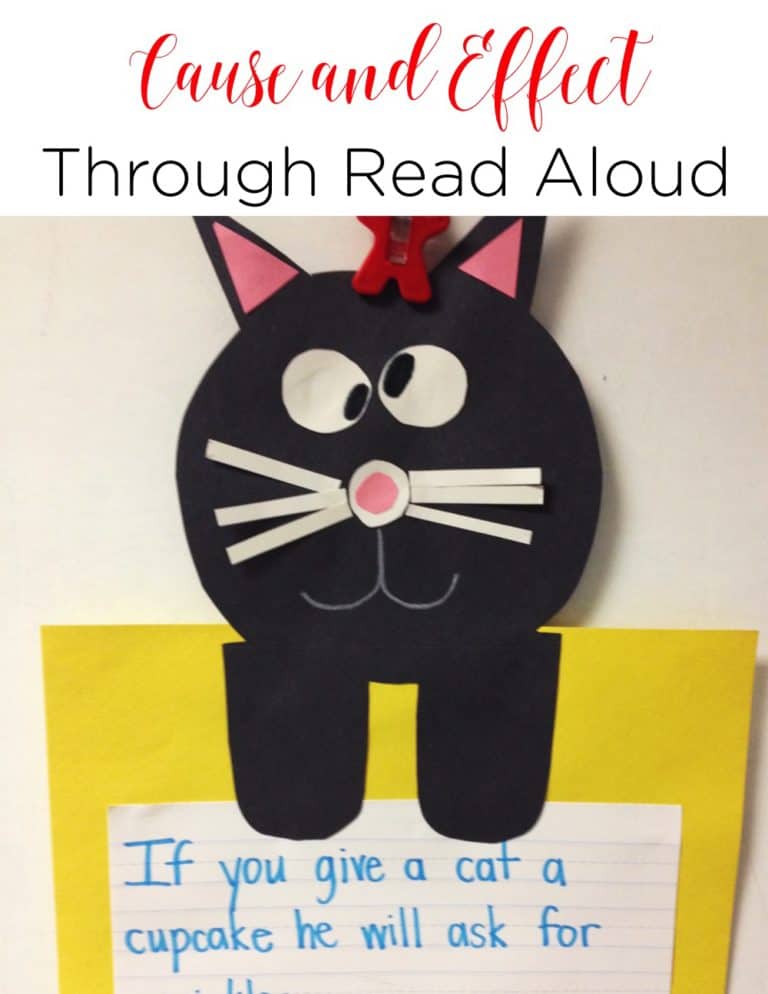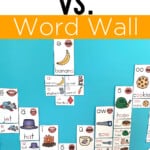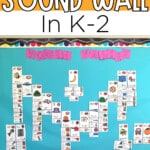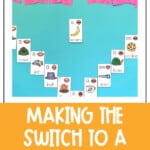


Learn what the differences are between a sound wall and a word wall to help boost your readers with stronger phonics and spelling skills.
A teacher friend shared this story with me and it’s too good not to reshare as we are diving into why we need word walls. She recalled a specific instance when one of her students wanted to spell the word ‘know’. She came up to her after going to the word wall and said, “I want to write the word “know” like “I know how to tie my shoe, but on the word wall, the word is spelled “no”. How do you spell “know”?”
My friend felt surprised that she knew n-o is not how we spell the word “know” as in information, and to be honest, I was, too! She then explained to her that in English there are some letters that are silent. Kn is one of those groups of letters. Looking back on that experience now, I can see the flaws of depending on a word wall.
Now that I’ve learned more and more about how students learn how to read, I’ve come to realize that a sound wall can make a much bigger impact on a student’s reading journey than a word wall. Let’s dive into what the differences are between sound walls and word walls.
A word wall displays the uppercase and lowercase letters of the alphabet in alphabetical order. The alphabet is displayed in a large, easy-to-read font. Then, words are added under the letters of which they start with. In primary classrooms, word walls typically contain high-frequency words as well as other important words students may need to know like students’ names, color words, and number words.
Teachers typically introduce a new high-frequency word, have the students practice it, and then post the new word onto the word wall. Then, students can refer to the word wall to help with reading or writing.
A sound wall consists of words organized by speech sounds or phonemes. It shows the letters or letter patterns that represent speech sounds. Sound walls also usually have a picture of how your mouth looks when you say that sound. This helps students see what the sound looks like when they say it.
Most primary teachers break a sound wall up into two walls – a consonant wall and a vowel wall. Sound walls show the different ways we spell the different sounds. For example, the consonant k would have a word and a picture with the /k/ sound represented, but it would also have c shown as the /k/ sound with a word and picture.
It is best to build your sound wall as you introduce those phonemes in your phonics instruction. You want to build it with your students over time so they have ownership of it, too!
You may also want to include your high-frequency words where appropriate so students can learn to identify spelling patterns.
On a sound wall, you will sort the words by the sounds a word makes. If there is an irregular spelling of the vowels in the word, make sure you make that clear for your students.
Sound walls provide a visual for students to see how their mouth looks when they say the different vowel sounds. Sound walls also show students the different ways a phoneme may be represented in spelling. My friend could have directed her student to the “kn” spelling of the word know if she had a sound wall in her classroom. Sound walls are a strong anchor for students as they are learning all the phonics patterns in the English language.
I love that sound walls also visually show your students the connection between their phonemic awareness skills and writing and reading (print). They are a great way to bring things full circle for your kids when it comes to reading and writing–input and output.
If you are looking for a resource to help you jump into using a sound wall in your classroom, I am super excited to share that we have one ready for you! There are many variations available so that you can display things in a way that best suits your students’ needs.
If you want some more resources on how to make shifts like switching from a word wall to a sound wall to implement better literacy practices, check out my blog on 4 Helpful Science of Reading Books.
Even if you feel a little unsure of how to implement a sound wall, I encourage you to do some research and just try it! If you’re already using a sound wall, what’s one important tip you’d share with a teacher new to sound walls? Let’s collaborate!

Want to use the latest research to boost your readers during small groups? This FREE guide is packed with engaging ideas to help them grow!

I’m a K-1 teacher who is passionate about making lessons your students love and that are easy to implement for teachers. Helping teachers like you navigate their way through their literacy block brings me great joy. I am a lifelong learner who loves staying on top of current literacy learning and practices. Here, you’ll find the tools you need to move your K-2 students forward!


| Cookie | Duration | Description |
|---|---|---|
| cookielawinfo-checkbox-analytics | 11 months | This cookie is set by GDPR Cookie Consent plugin. The cookie is used to store the user consent for the cookies in the category "Analytics". |
| cookielawinfo-checkbox-functional | 11 months | The cookie is set by GDPR cookie consent to record the user consent for the cookies in the category "Functional". |
| cookielawinfo-checkbox-necessary | 11 months | This cookie is set by GDPR Cookie Consent plugin. The cookies is used to store the user consent for the cookies in the category "Necessary". |
| cookielawinfo-checkbox-others | 11 months | This cookie is set by GDPR Cookie Consent plugin. The cookie is used to store the user consent for the cookies in the category "Other. |
| cookielawinfo-checkbox-performance | 11 months | This cookie is set by GDPR Cookie Consent plugin. The cookie is used to store the user consent for the cookies in the category "Performance". |
| viewed_cookie_policy | 11 months | The cookie is set by the GDPR Cookie Consent plugin and is used to store whether or not user has consented to the use of cookies. It does not store any personal data. |



3 Responses
Many thanks for sharing this on sound walls. Never heard of it before and found it super interesting.
Maria
If you search Science of Reading – Kg to Grade 2 on facebook, there is a long professional facebook discussion group that gives you suggestions and updates into the science of reading. Research has suggests to move away from word walls and implement sound walls.
I am an RTI reading teacher and would love to use this in my room! Can you link where you purchased your sound wall? Thank you!